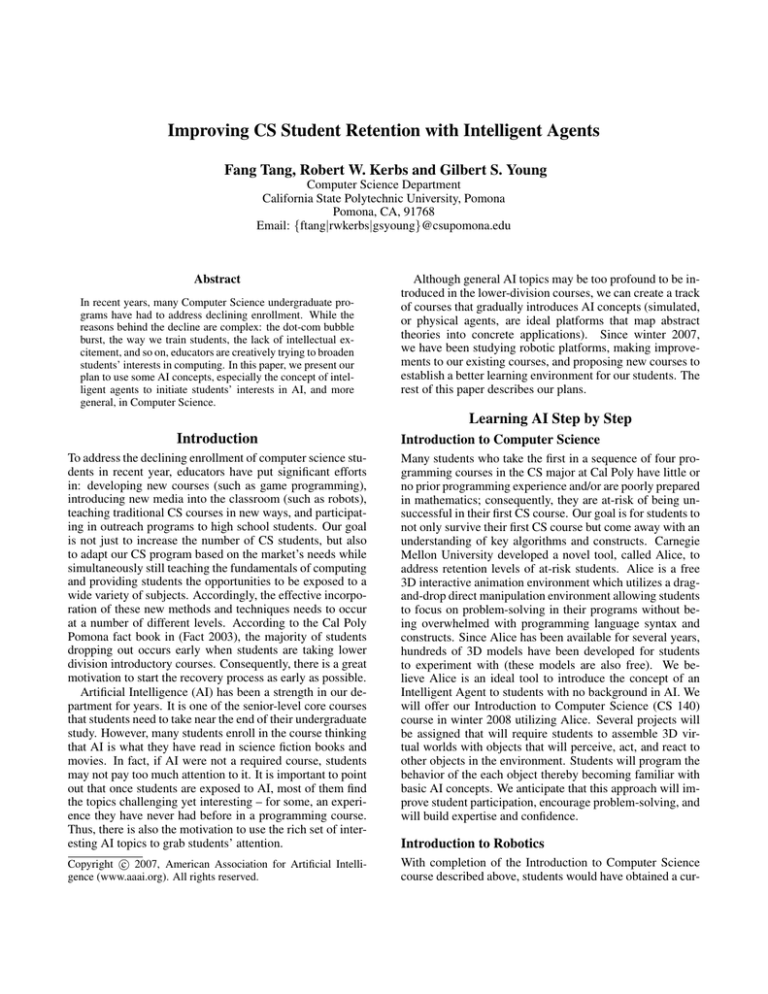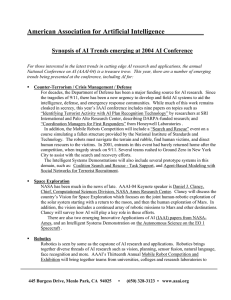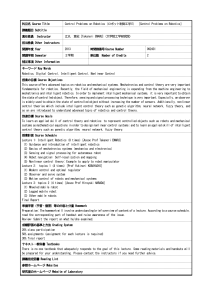
Improving CS Student Retention with Intelligent Agents
Fang Tang, Robert W. Kerbs and Gilbert S. Young
Computer Science Department
California State Polytechnic University, Pomona
Pomona, CA, 91768
Email: {ftang|rwkerbs|gsyoung}@csupomona.edu
Abstract
In recent years, many Computer Science undergraduate programs have had to address declining enrollment. While the
reasons behind the decline are complex: the dot-com bubble
burst, the way we train students, the lack of intellectual excitement, and so on, educators are creatively trying to broaden
students’ interests in computing. In this paper, we present our
plan to use some AI concepts, especially the concept of intelligent agents to initiate students’ interests in AI, and more
general, in Computer Science.
Although general AI topics may be too profound to be introduced in the lower-division courses, we can create a track
of courses that gradually introduces AI concepts (simulated,
or physical agents, are ideal platforms that map abstract
theories into concrete applications). Since winter 2007,
we have been studying robotic platforms, making improvements to our existing courses, and proposing new courses to
establish a better learning environment for our students. The
rest of this paper describes our plans.
Learning AI Step by Step
Introduction
Introduction to Computer Science
To address the declining enrollment of computer science students in recent year, educators have put significant efforts
in: developing new courses (such as game programming),
introducing new media into the classroom (such as robots),
teaching traditional CS courses in new ways, and participating in outreach programs to high school students. Our goal
is not just to increase the number of CS students, but also
to adapt our CS program based on the market’s needs while
simultaneously still teaching the fundamentals of computing
and providing students the opportunities to be exposed to a
wide variety of subjects. Accordingly, the effective incorporation of these new methods and techniques needs to occur
at a number of different levels. According to the Cal Poly
Pomona fact book in (Fact 2003), the majority of students
dropping out occurs early when students are taking lower
division introductory courses. Consequently, there is a great
motivation to start the recovery process as early as possible.
Artificial Intelligence (AI) has been a strength in our department for years. It is one of the senior-level core courses
that students need to take near the end of their undergraduate
study. However, many students enroll in the course thinking
that AI is what they have read in science fiction books and
movies. In fact, if AI were not a required course, students
may not pay too much attention to it. It is important to point
out that once students are exposed to AI, most of them find
the topics challenging yet interesting – for some, an experience they have never had before in a programming course.
Thus, there is also the motivation to use the rich set of interesting AI topics to grab students’ attention.
Many students who take the first in a sequence of four programming courses in the CS major at Cal Poly have little or
no prior programming experience and/or are poorly prepared
in mathematics; consequently, they are at-risk of being unsuccessful in their first CS course. Our goal is for students to
not only survive their first CS course but come away with an
understanding of key algorithms and constructs. Carnegie
Mellon University developed a novel tool, called Alice, to
address retention levels of at-risk students. Alice is a free
3D interactive animation environment which utilizes a dragand-drop direct manipulation environment allowing students
to focus on problem-solving in their programs without being overwhelmed with programming language syntax and
constructs. Since Alice has been available for several years,
hundreds of 3D models have been developed for students
to experiment with (these models are also free). We believe Alice is an ideal tool to introduce the concept of an
Intelligent Agent to students with no background in AI. We
will offer our Introduction to Computer Science (CS 140)
course in winter 2008 utilizing Alice. Several projects will
be assigned that will require students to assemble 3D virtual worlds with objects that will perceive, act, and react to
other objects in the environment. Students will program the
behavior of the each object thereby becoming familiar with
basic AI concepts. We anticipate that this approach will improve student participation, encourage problem-solving, and
will build expertise and confidence.
c 2007, American Association for Artificial IntelliCopyright gence (www.aaai.org). All rights reserved.
With completion of the Introduction to Computer Science
course described above, students would have obtained a cur-
Introduction to Robotics
sory understanding of intelligent agents - a software agent
that can perceive its environment and act and react somewhat rationally while trying to arrive at a goal state. The
next step is to provide a platform from which students can
further explore how to make an agent act rationally in its
environment. We have proposed the creation of an introductory robotics course for undergraduates called, Introduction to Robotics. The major reason to have an introductory
course rather than an advanced course is to attract students’
attention in the early stage. We plan to cover topics such as
robot behavior, sensing, robot control architectures, navigation and path planning. Some basic AI techniques will also
be introduced such as hill climbing and simulated annealing. Each topic will be coupled with an individual or group
project that reinforces the theoretical lessons learned. The
possible projects include robot navigation, obstacle avoidance, line following, wall following and foraging. Upon the
completion of this course, students are expected to acquire
the knowledge for building intelligent agents that can accomplish simple tasks. They are also exposed to some useful
AI techniques and experience the difficulties when linking
theories with real-world applications. This experience better prepares students for future study while motivating them
through the study of AI.
Prior work such as (Dodds et al. 2006) have shown the advantages of introducing physical robots in the classroom to
enhance students’ hands-on experience and motivate them
for pursuing advanced education in AI and robotics. Another important aspect is that physical robots can help create
cooperative learning environments; where students can sit
together and work on problems in the lab instead of doing it
all by their own because of the commute culture on our campus and the nature of programming. Additionally, learning
and knowledge sharing can be greatly enhanced through student group projects. In summer 2007, we tested two robotic
platforms (both cost about the same): Lego Mindstorm NXT
and iRobot Create. The NXT robot better suits the needs
of our proposed introductory course because of its versatile
sensors, fast integration, Java programming support (such as
LeJos). Two senior-level students have tested NXT’s sensing capabilities and accomplished a simple wall-following
task as an independent study. The students discovered that
seemingly perfect theoretical solutions may not work well
in a real world situation with the noisy sensing data and uncertainties – a new experience for them.
Artificial Intelligence
AI is a very broad field and can be applied to many different
areas. We plan to use intelligent agents to introduce AI in
our senior-level course, Artificial Intelligence (CS 420). For
a regular 11-week quarter, we can select 3 to 4 topics from
problem solving, planning, robotics, reasoning and learning.
Traditionally, the AI project assignments have a lot to do
with toy problems, like 8-puzzle and n-queen. We can design more practical projects if students have good knowledge in robotics. Examples of projects include: using A* to
find the optimal path in a topological map; using local search
for robot navigation in an environment with dense obstacles;
task allocation with constraints; path planning; and using re-
inforcement learning for a robot to accomplish simple tasks.
The purpose of using robots here is to help students easily
see the effects of these AI techniques and be able to apply
them to future problems.
With the fundamental concepts obtained in the two
courses mentioned above, students will be at a better starting point to successfully take CS 420. Although many of
the projects are robot based, we do not expect the students
to spend too much time on robot configuration, which would
deviate too far from our goal of passing on AI concepts and
theories. We use Player/Stage (Gerkey, Vaughan, & Howard
2003) for most of the projects. A lab session will be dedicated for understanding the basic Player/Stage API and its
configuration. Another possible installation of Player/Stage
for Windows OS is to use RoboDeb (Jacobsen & Jadud
2007). We have tested both configurations with Java and
C++ work. We are aware of the tradeoffs between physical
robots and simulated robots as shown in (Blank et al. 2006;
Veloso et al. 2006). We believe that using simulated robots
has the advantages of shorter programming cycle, versatile
applications, easy maintenance, less budget for an AI course.
We have started to incorporate these new changes into CS
420 in Fall 2007 and will thoroughly evaluate the results using questionnaires at the end of the term.
Summary and Future Work
We have presented our plan to use the concept of intelligent
agents in a series of courses to motivate students’ interests
in AI and Computer Science. We look forward to seeing the
feedbacks from students and exploring more effective ways
to engage students in learning.
Acknowledgments
This work is partially supported by the College of Science
Quality Learning Fund, which was established to support
new initiatives to enhance learning centered mission of the
College of Science at Cal Poly Pomona.
References
Blank, D.; Kumar, D.; Meeden, L.; and Yanco, H. 2006.
The Pyro tookit for AI and robotics. AI magazine 27(1).
Dodds, Z.; Greenwald, L.; Howard, A.; Tejada, S.; and
Weinberg, J. 2006. Components, curriculum, and community: Robots and robotics in ungraduate AI education. AI
magazine 27(1).
Fact. 2003. Statistics of 1 year retention rate by major
group. Fact book, Cal Poly Pomona.
Gerkey, B.; Vaughan, R.; and Howard, A. 2003. The
player/stage project: Tools for multi-robot and distributed
sensor systems. In Proceedings of the 11th International
Conference on Advanced Robotics, 317–323.
Jacobsen, C. L., and Jadud, M. C. 2007. Concurrency,
robotics, and RoboDeb. Technical report, Papers from the
AAAI Spring Symposium.
Veloso, M.; Rybski, P.; Lenser, S.; Chernova, S.; and Vail,
D. 2006. CMRoboBits: Creating an intelligent AIBO
robot. AI magazine 27(1).





